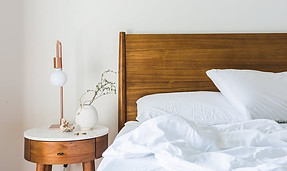
Both my eczema warriors, son J and daughter M were skin prick tested for quite bad reaction to dust mites. It would cause their skin to flare up in inflamed, angry patches. To relieve dust mite allergy in them, we took great care in our living habits and behaviour, and the environment at home.
What are dust mites
Dust mites are microscopic bugs that feed on the dead skin cells that we shed daily. Oh this is aplenty in my home where almost on a daily basis, J and M would itch and scratch their eczema skin. The dust mites sure enjoy their hearty feast, in their bedrooms, on our sofa, etc.
Dust mites also love warm and humid (they thrive in above 50% humidity) places. Which is the exact kind of climate we have over here! No wonder they love us to bits!
The frustration with dust mites is that they are literally everywhere, and we can’t see them. So no matter how hard I try to keep the house clean, I would never know if I have done enough. We’re also not in control of places outside the home, like in their schools, in restaurants, on public transport, in shopping malls, etc.
At the end of the day, we can only keep trying to do our best, so that whatever environment that is within our control is kept as free of dust mites as possible. If we don’t do that, the allergic little ones would be in a perpetual inflamed state.
Symptoms of dust mite allergy
Just like with many allergic reactions, dust mites can trigger asthma and other nasal irritations as well as skin issues. Symptoms of dust mite allergy include:
- itching on the skin
- difficulty breathing, wheezing, asthma-like symptoms
- coughing
- sneezing
- runny nose or congestion in airway
- red, teary eyes
The allergic reaction stems from our bodies’ immune system response to what it perceives as foreign substances: the protein in the dead bodies of dust mites and their waste matter. Yeah, tell me about disgusting.
Triggers of dust mite allergy

Dust mites can reach us through many small particles floating around in the air or scurrying around, or through some furnishing at home:
- dust particles (obviously)
- cockroaches (eeeeeks!)
- pet fur, bird feather
- fabric fibre
- soft toys fur
- carpet fibre
- curtain drapery
- sofa upholstery
- pillows and mattresses
So to relieve the symptoms of dust mite allergy means getting rid of, or minimising the dust on these items.
How we relieve dust mite allergy
- Remove the prime suspects – change out your carpeting and replace with a simple hard flooring, it’s really a lot easier to maintain. Replace curtain drapery with wooden blinds or vinyl blinds, anything non-fabric. Replace sofa upholstery with something non-fabric, even synthetic leather is a better material in not hiding the dust mites.
- Wet mop and wet wipe instead of dusting it up – incorporate wet mopping and wet wiping as your cleaning regime, instead of dusting, which stirs up all the dust that was previously settled, and tends to irritate the allergic ones even more.
- Get the allergic ones to wear their dustproof masks when you’re cleaning up the house. Or if possible, carry out the cleaning when the allergic ones are away.
- Protect your pillows and mattresses with anti dust mite coverings, which you can take out to wash on a regular basis.
- Change the bed sheets and pillow cases once every week, and wash them in hot water.

- If you must have your soft toys, protect them in transparent plastic covering, so you can replace them regularly. Better still, keep them in storage.
- Keep your pets outside the house if possible. If not, then at least ban them from entering your bedrooms.
- Any means that will keep cockroaches out of the house.
- Reduce the humidity in the air by using air-conditioning or a dehumidifier.
- Run a HEPA (high efficiency particulate air) air purifier in the bedrooms of the allergic ones.
- Use a HEPA filter in your vacuum cleaner, to trap as much dust from the air as possible. And do change out your filters every 3 to 4 months, to optimise their effectiveness in doing their job.
When all these fail
When having done all the above measures, and the body still reacts actively, medications would usually help to alleviate the symptoms somehow, and make the child more comfortable. Decongestants and antihistamines are our go-to in times like these. In fact, they are as far as we had to go, thankfully nothing more serious than that. But of course if your child has a known allergen that would give him a serious reaction, please do stick to the doctor’s advice.
NAET to eliminate dust mite allergy?
This is something that has been at the back of my mind – using Nambudripad’s Allergy Elimination Techniques (NAET) to get rid of my children’s dust mite allergy, among a few other allergies. What is holding me back is the huge cost involved, the lack of a well-reputed practitioner in my area, as well as the uncertainty of whether it would help my children at all.
It works for some, not for others. If you have the financial resources, this may be worth a try.
But for us, for now, it is probably not the season yet.
Build up immunity, heal from inside out
As always, I believe that when you build up the child’s health and immunity by healing them from inside out, the allergies would disappear over time, as the body gets stronger and stops reacting to these daily irritants.

That’s an awesome website and it hits the spot with a lot of people. My mother has eczema/psoriasis and she swears on natural methods (like the right nutrition), that’s how I grew up. I believe strenghtening children’s immune system is the best way to contain allergies.
I have seasonal allergies, during this time I’m more sensitive to dust and animal hair. It used to be worse when I was younger but since then I have my allergies more under control by strengthening my immune system (like eating more local honey, it helps!) and detoxing my body.
For topical use: have you ever used tea tree oil (maleluca)? A friend of mine uses it for her child’s eczema and she says it works. I have used it several times on my children when they broke out on their skin in summertime (one time we used it on something that looked like a staph infection on my daughter’s thigh and after applying tea tree oil every day it disappeared).
Not only this article, this website has a lot of very useful information for people with allergies, and it comes from personal experiences.
Hi Andrea,
Thank you for your suggestion, I will definitely try out tea tree oil for my kids’ eczema.
Wow your mum is such an enlightened lady, to actually know to use natural remedies to work on your health. You sure had a great start, with your mum’s expertise and know-how.
Hello, my daughters and I have severe allergies to dust mites as well. It’s just an ongoing irritating allergic reaction year round. We do several of your suggestions such as using the special dust mite pillowcases and mattress encasings, having HEPA filters around as well as using a vacuum with the HEPA filter. There are so many options around today that help symptoms caused by dust mites!
Hi Lynne,
Yeah dust mites are really so pervasive, they’re everywhere around us. It’s really hard to keep it under control. But like you said, there are so many products these days that are able to help us cope with this allergy, so we’re quite fortunate in that sense.
I hope you and your daughters find relief from this irritating allergen.
One of the reasons I am very cautious in sleeping over at a friend’s or relatives’ house is the fear that I might come in contact with dust mite, again.
When I was a kid, my parents sent me over to our neighbor’s house for a sleep over because they had to travel and won’t be back until the next day. I didn’t know they had dust mites, which I unfortunately brought in to our home. Only when I started scratching my back, legs and thighs and was sneezing continuously that my mom realized I came in contact with dust mites. T’was also the time I found out I had allergic rhinitis. Is it possible to have dust mite allergy and at the same time allergic rhinitis? Or are they one and the same?
Anyway, We had to clean the entire house, turned everything upside down and inside out.
Hi Alice,
Actually it is more likely that you were already exposed to dust mites before your sleepover at the neighbour’s house, as dust mites are literally everywhere. They are in the air we breath, places where humans live, there will be dust mites, as they love to feed on our dead skin. Could you be referring to bed bugs or some other tiny bugs that infested your neighbour’s house and caused your allergic reactions?
Anyway allergic rhinitis could very well be triggered by dust mites, pollen, animal dander, or any other allergens that your respiratory tract is sensitive and reacts to. So you’re right. Allergic rhinitis is actually the name we give to the condition in which you react to allergens and display symptoms like runny or stuffy nose, sneezing, red and watery eyes, swelling around the eyes, etc.
I hope the condition is now better for you, since the allergens have been removed.
Thanks, Joo, for this very informative post once again. My husband is (mildly) allergic to dust mites, and while it’s not too difficult to get on top on this here in South Africa (the humidity levels are generally low and carpets in houses are non-existent), we had a hard time when we lived on a houseboat on a tidal river in the UK. We permanently had a dehumidifier running in the bedroom, a vacuum cleaner with HEPA filter, and I was treating all the soft furnishing regularly to get rid of the critters (unknowingly triggering my little one’s eczema). As you said, it’s complicated… But I’ve just learned about a few more ways to deal with them, thanks to you. 🙂
Hi Isabel,
I’m glad the suggestions here can help with your little one’s eczema. You’re so right that humidity is such a big factor when it comes to managing dust mites! That’s why we have a perpetual headache over here, our average humidity is 85%!
Thanks joo for directing me to this post on dust mites.
What about mint or peppermint. I read somewhere that insects don’t like the smell of mint, so a plant/plants spread around is meant to be effective.
I throw peppermint oil around mmm… I’m not sure, but it certainly smells nice.
Your thoughts
Michele
Hi Michele,
Mint and peppermint are great ideas! I’m going to have to try those.
Someone also mentioned to me before that eucalyptus works for dust mite allergy. I’ll be writing about it if it works for us too!